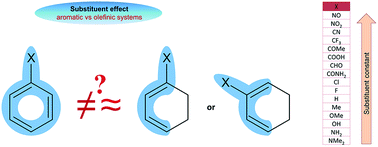Difference in pi-electron delocalization for monosubstituted olefinic and aromatic systems
Abstract
Application of HOMA (Harmonic Oscillator Model of Aromaticity) to a series of monosubstituted derivatives of cyclohexa-1,3-diene (olefinic) and benzene (aromatic) revealed an increase of the pi-electron delocalization in olefinic systems and a decrease in the case of aromatic systems (in comparison to unsubstituted species). Due to the nature of the system to which the substituents are attached, the range of changes of the electron donating/attracting (ED/EA) properties of the substituents may be as large as 30% of the total variation of ED/EA properties for all substituents considered.


 Please wait while we load your content...
Please wait while we load your content...